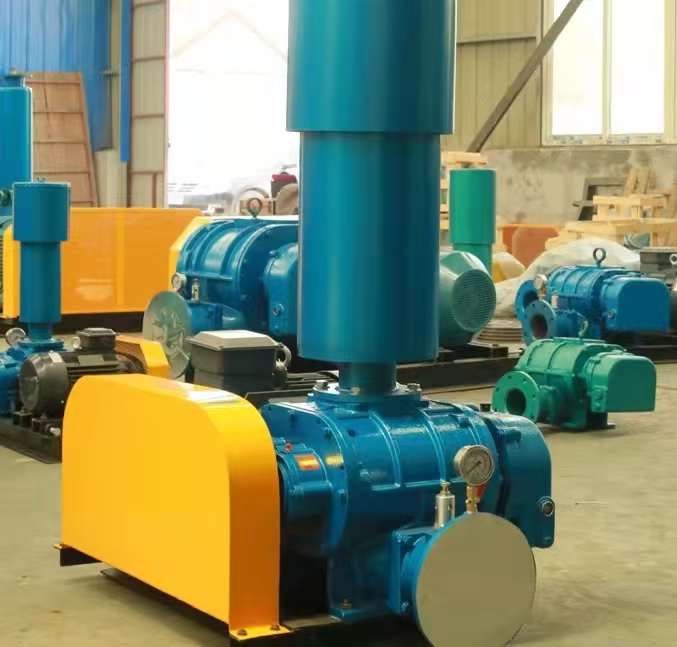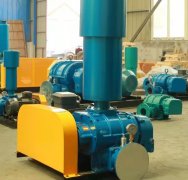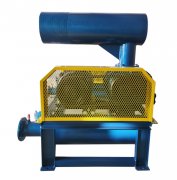The core performance of Roots blowers in aquaculture is to increase oxygen and improve the water environment, which directly affects the survival rate, growth rate, and yield of aquaculture organisms. The following is an analysis of its specific performance, function, and principle:
---

**1、 Core performance role**
1. * * Oxygenation**
-Dissolved oxygen enhancement: Air is injected into the water in the form of tiny bubbles through microporous aeration devices (nanotubes, aeration discs), greatly increasing the gas-liquid contact area and allowing oxygen to dissolve quickly.
-Effect: It can increase dissolved oxygen (DO) in water from 2-3 mg/L in its natural state to 5-8 mg/L (meeting the requirements of high-density aquaculture).
-* * Comparative advantage * *: It saves 20-30% energy compared to traditional impeller aerators, especially suitable for deep water (≥ 2 meters) ponds.
2. Water activation**
-Stratification: Forcing airflow to promote the circulation of water up and down, breaking the stratification phenomenon of temperature and dissolved oxygen (such as high temperature and low oxygen in the surface layer and low temperature and low oxygen in the bottom layer in summer).
-* * Release of harmful gases * *: Promote the overflow of toxic gases such as ammonia nitrogen (NH) and hydrogen sulfide (HS) from water bodies.
3. * * Promote microbial metabolism**
-Aerobic bacterial reproduction: A high dissolved oxygen environment accelerates the decomposition of organic waste (residual feed, feces), reduces bottom sludge accumulation, and inhibits anaerobic pathogenic bacteria.
---
**2、 Detailed explanation of performance advantages**
|* * Performance indicators * * | Advantages of Roots blower * * | * * Impact on aquaculture * *|
|--------------------|-------------------------------------------------------|---------------------------------------------|
|* * Stable oxygen supply capacity * * | Continuous operation without pulsation, stable air pressure (0.1~0.5 bar) | Avoid dissolved oxygen fluctuations that may cause stress or floating heads in fish|
|* * Low energy consumption * * | Low pressure and high air volume characteristics, energy-saving compared to centrifugal fans | Low long-term operating costs, suitable for large-scale aquaculture|
|Deep water adaptability | High pressure models can support aeration at depths of 4-6 meters | Suitable for deepwater aquaculture of shrimp, sea cucumber, and other species|
|* * Uniform oxygenation * * | Aeration pipes are evenly distributed at the bottom of the pool, without dead corners | Avoiding local hypoxia and increasing breeding density (such as increasing yield by 30 per mu)|
---
**3、 Key performance parameters and selection**
1. * * Airflow (key parameter)**
-* * Calculation formula * *:
\[
\Text {required air volume (m3/h)}=\ text {water volume (m3)} \ times \ text {air exchange rate (times/hour)}
\]
-Ventilation rate reference:
-Ordinary fish pond: 0.5~1 times/hour
-High density intensive farming (such as shrimp): 1.5-2 times/hour
2. * * Pressure (related to water depth)**
-* * Empirical formula * *:
\[
\Text {required pressure (bar)}=0.1 \ times \ text {water depth (meters)}+0.05 \ text {pipeline loss)}
\]
-Example: A pressure of ≥ 0.25 bar is required for a water depth of 2 meters.
3. Energy Efficiency Ratio**
-* * Preferred indicators * *: The higher the oxygen supply per unit power (kgO/kW · h), the better, and the quieter type (<75 dB) is more suitable for breeding farms.
---
**4、 Performance adaptation for different aquaculture scenarios**
|Breeding mode * * | * * Performance requirements * * | * * Roots blower configuration suggestions * *|
|--------------------|-----------------------------|---------------------------------------------|
|* * Soil pond aquaculture * * | Large area, medium low density | Multiple low-power fans are connected in parallel, with an air volume of 30-50 m3/h and a pressure of 0.2 bar|
|* * Industrialized circulating water * * | 24-hour stable high dissolved oxygen | Water cooled Roots blower, variable frequency control, air volume calculated based on water circulation rate of 1-2 times/hour|
|High Density Shrimp and Crab Pond | High Oxygen Demand at the Bottom | Nano Aeration Tube+High Pressure Roots Fan (0.4 bar or above)|
|* * Nursery pond * * | Micro bubble, low noise | Low power (1.5~3 kW) silent model, equipped with microporous aeration stone|
---
**5、 Performance optimization direction**
1. * * Variable frequency control * *: Real time adjustment of speed based on dissolved oxygen sensor to avoid excessive oxygen supply and energy waste.
2. * * Aeration device upgrade * *: The oxygen utilization rate of nanotubes is increased by 40-60% compared to traditional aeration discs.
3. * * System maintenance * *: Regularly clean the aeration tube (to prevent blockage) and check the lubricating oil (to prevent bearing overheating).
---
**6、 Common Problems and Performance Assurance**
-* * Problem * *: Decreased oxygenation effect
-* * Reason * *: Blocked aeration tube, loose fan belt, or dirty filter element.
-Solution: Clean the aeration pipe every month and check the fan transmission system.
-* * Problem * *: Fan overheating and shutdown
-Reason: Continuous overload operation or insufficient cooling (water-cooled type needs to check the water pump).
-Solution: Install a cooling fan or reduce the operating time.
---
**Summary**
The core performance of Roots blowers in aquaculture is stability and energy efficiency. Through scientific selection and reasonable layout, the breeding density and survival rate can be significantly improved. In practical applications, it is necessary to comprehensively design system parameters based on water body scale, aquaculture species, and climate conditions. If a specific selection plan is needed, further analysis of pond size and breeding species can be provided.



